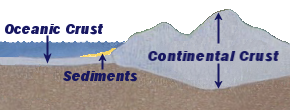Chapter: Formation of Mountain Ranges
Plate Boundaries
2. Convergent Boundaries
We mainly find the convergent boundaries where an ocean meets a continent. There are active and passive continental edges. There is hardly any action at the passive edges. At the active ones oceanic crust is subducted underneath the continental crust, because the density of the oceanic crust is much higher.

|
Differences between oceanic and continental crust:– The composition of the two crusts: they are built out of different rocks. That's why– the density is different as well. The density of the oceanic crust is higher. This is primarily important when subduction takes place. – The thickness: The continental crust is much thicker and usually reaches 18.7 miles up to 37 miles below a mountain range as opposed to the oceanic crust which reaches about 3.7 miles. |
Not everything runs smoothly during the subduction process, the rocks get stuck and
the built up tension releases abruptly – earthquakes result.
At a certain depth magma can form out of the oceanic crust. Sometimes magma chambers form. From these chambers, magma can rise and volcanism could develop. This is for example the case in the Andes. It's also possible that two continents crash and a mountain range forms. Let's take the Himalayas as a prime example, here India crashes against Asia.
So you can see, we slowly get closer to the formation of mountain ranges. Let's take a closer look at the orogenesis.

